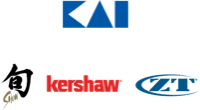We use cookies to make your experience better. To comply with the new e-Privacy directive, we need to ask for your consent to set the cookies. Learn more.

Automatic Knife Release Form
You must read and fill out this form before Kai USA, Ltd. can sell to you, or ship to you, any Automatic or Butterfly Knives. By electronically signing this online form, you confirm that you are in compliance with the federal statutes shown below as well as any applicable state and local regulation.
By placing an order or receiving a product service (such as warranty repair service) from us, you agree that you meet any or all of the following criteria:
APPLICABLE FEDERAL STATUTES
18 U.S.C. § 1716 (G) (2) (1-4) provides, in summary:
Switchblade (automatic) knives can be shipped to civilian and armed forces supply or procurement officers and employees of the federal government ordering or procuring or purchasing such knives in connection with activities of the Federal government; to supply or procurement officers in the National Guard, the Air National Guard or militia of the state or territory of the District of Columbia ordering, procuring or purchasing such knives in connections with the activities of such organizations; to supply or procurement officers or employees of the municipal government of the District of Columbia or the government of any state or territory of any county, city or other political subdivision of a state or territory ordering, procuring or purchasing such knives in connection with the activities of such government.
15 U.S.C. § 1244 provides, in summary:
Knives can be shipped by common carrier; that sale, transportation or distribution, possession or introduction into interstate commerce of switchblade knives is authorized if it is pursuant to a contract with the armed forces; or, any member or employee thereof acting in the performance of his or her duty may possess switchblade knives and may have them shipped to him and sold to him or her. The possession and transportation upon his or her person of a switchblade knife or a blade 3 inches or less is authorized to any handicapped individual who has the use of only one arm.
STATE LAW PROVISIONS
It would be impossible to provide an exhaustive review of the laws that may apply in the various fifty states and in the various counties, parishes, municipalities, and other political subdivisions within each state. By signing this form below, you will be certifying that in addition to complying with federal law, you have determined which, if any, state or local laws apply to you, and that you are acting in compliance with those laws.
No Post Office Box addresses can be used on this form. Item(s) must be sent in going UPS or Fed Ex. No USPS shipments will be accepted. If the address that you have filled out on this form is no longer a valid address, you must contact us and fill out a new form.
f-18 form successfully submitted
A confirmation will be sent to your email shortly. You can find your signed form in your Account.
Please note, you cannot add to cart without signing the f-18 agreement


- 1800 SW Teton Avenue
- Tualatin, OR 97062
- Phone: 503-682-1966
- Toll Free: 800-325-2891
- Fax: 503-682-7168
- kaiusa.com
Blade Edges & Grinds
About ZT edges
ZT pocketknives have two main types of edge, plain and partially serrated. The plain edge is also sometimes called a “fine” or “straight” edge; the majority of ZTs feature a plain edge. Some ZTs offer a partially serrated edge.
Here are the advantages of each type and the best way to put each to use.
The plain edge
A plain edge is the edge style everyone is familiar with. The blade steel is ground and sharpened to a very fine point along one edge. The sharpened edge is a uniform width from the heel to the tip of the blade. Generally, the sharpened edge is visually lighter than the rest of the blade because the sharpening process also polishes the edge. All ZT knives are hand sharpened by our expert sharpeners.
The plain edge is a general-purpose cutting edge, the one most people need for daily tasks. From opening packages to breaking down cardboard to slicing up an apple for a snack, the plain-edged pocketknife is perfect for the job.
Advantages:
- Multipurpose cutting
- Excels at push cuts, slicing cuts, and precision work
- Easy to care for
- Easy to resharpen when needed


The partially serrated edge
The plain edge is extremely useful, which is why most ZTs have a plain edge. However, there are times when a serrated edge is the right tool for the job. When cutting fibrous materials like rope or webbing (think seatbelts) or even when sawing through bits of wood or hide, the toothlike serrations can cut more quickly and efficiently. The partially serrated portion of the blade is sharpened on a single side, making the edge even sharper, while the serrations dig in to cut through the tough stuff.
ZT’s partially serrated blades combine the advantages of the plain edge with those of the serrated edge for the best of both worlds.
Advantages:
- Added cutting versatility with both edge styles
- Partial serration enables easy cutting of fibrous materials
- Serrations stay sharper longer
While serrations do tend to retain their sharpness longer, when it comes time to resharpen, serrations take more effort and require special tools.


About ZT grinds
The grind of a knife is how the knife blank is thinned and narrowed by grinding so that the blade becomes thin enough along the edge to cut with it. ZT uses two main types of grinds on our knives: flat and hollow.
For more info about other parts or aspects of a blade, see Knife Anatomy.
The flat grind
A flat grind is exactly what it sounds like: the blade is ground flat from the spine to the edge on both sides. In cross section, it would look like a triangle. ZT also puts an edge bevel on the blade, which forms the actual cutting edge.
The flat grind offers good cutting capabilities, strength, and depending on blade thickness, can also offer chopping abilities.
The slicer grind, designed by Rick Hinderer, is a type of flat grind used on some ZT knives made in collaboration with Rick. In this case, the blade grind tapers from spine to edge, but also from back of the blade to front. This enables to front of the blade to be an excellent slicer, while the thicker back part of the blade can be used for tougher push or draw cuts.


The hollow grind
For a hollow grind, the blade is ground so that it is slightly concave on both sides of the blade. This thins the blade and enables a very thin, sharp edge, making this style of knife an excellent slicer.
Hollow grinds are useful on any knife that needs to be able to slice, making them excellent for every day carry. They are also often found on hunting knives for that same purpose. As with the flat grind, ZT also puts an edge bevel on our hollow-ground knives.


ZT chooses blade edges and grinds based on the intended use of the knife, the knife’s design and materials, as well as manufacturing considerations. Learn about blade styles and profiles here.